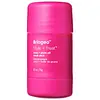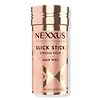What's inside
What's inside
 Key Ingredients
Key Ingredients

 Benefits
Benefits

 Concerns
Concerns

 Ingredients Side-by-side
Ingredients Side-by-side

Ricinus Communis Seed Oil
MaskingCoco-Caprylate/Caprate
EmollientEuphorbia Cerifera Wax
Vitis Vinifera Seed Oil
EmollientHydrogenated Castor Oil
EmollientOleic/Linoleic/Linolenic Polyglycerides
EmollientStearyl Behenate
EmollientCopernicia Cerifera Wax
Helianthus Annuus Seed Wax
Skin ConditioningRosa Canina Fruit Oil
EmollientCocos Nucifera Oil
MaskingArgania Spinosa Kernel Oil
EmollientGlyceryl Stearate Se
EmulsifyingPrunus Domestica Seed Oil
Skin ConditioningCitrus Junos Peel Extract
Skin ConditioningOlea Europaea Oil Unsaponifiables
Skin ConditioningShorea Robusta Resin
TonicRhus Verniciflua Peel Wax
Kaolin
AbrasiveHelianthus Annuus Seed Oil
EmollientPanthenol
Skin ConditioningNiacinamide
SmoothingBiotin
AntiseborrhoeicFolic Acid
Skin ConditioningSodium Starch Octenylsuccinate
AbsorbentMaltodextrin
AbsorbentCalcium Pantothenate
Sodium Ascorbyl Phosphate
AntioxidantTocopheryl Acetate
AntioxidantPyridoxine Hcl
Skin ConditioningSilica
AbrasiveParfum
MaskingRicinus Communis Seed Oil, Coco-Caprylate/Caprate, Euphorbia Cerifera Wax, Vitis Vinifera Seed Oil, Hydrogenated Castor Oil, Oleic/Linoleic/Linolenic Polyglycerides, Stearyl Behenate, Copernicia Cerifera Wax, Helianthus Annuus Seed Wax, Rosa Canina Fruit Oil, Cocos Nucifera Oil, Argania Spinosa Kernel Oil, Glyceryl Stearate Se, Prunus Domestica Seed Oil, Citrus Junos Peel Extract, Olea Europaea Oil Unsaponifiables, Shorea Robusta Resin, Rhus Verniciflua Peel Wax, Kaolin, Helianthus Annuus Seed Oil, Panthenol, Niacinamide, Biotin, Folic Acid, Sodium Starch Octenylsuccinate, Maltodextrin, Calcium Pantothenate, Sodium Ascorbyl Phosphate, Tocopheryl Acetate, Pyridoxine Hcl, Silica, Parfum
Petrolatum
EmollientCocos Nucifera Oil
MaskingHydrogenated Castor Oil
EmollientCaprylic/Capric Triglyceride
MaskingEuphorbia Cerifera Wax
Oryza Sativa Bran Wax
Skin ConditioningLauryl Laurate
Skin ConditioningC18-21 Alkane
SolventParfum
MaskingTocopheryl Acetate
AntioxidantBenzyl Alcohol
PerfumingBenzyl Salicylate
PerfumingCitronellol
PerfumingEugenol
PerfumingGeraniol
PerfumingHexyl Cinnamal
PerfumingLimonene
PerfumingLinalool
PerfumingIngredients Explained
These ingredients are found in both products.
Ingredients higher up in an ingredient list are typically present in a larger amount.
Cocos Nucifera Oil is obtained from the kernels of the coconut fruit. In other words, this is coconut oil.
Coconut Oil is rich in fatty acids with lauric acid making up the majority of these. It also contains linoleic acid. Due to this high fatty acid content, coconut oil helps trap moisture and soften skin.
Despite being antibacterial, coconut oil may not be great for acne-prone skin. It is comedogenic and may clog pores. This ingredient may not be safe for malassezia or fungal acne.
Note: Coconut Oil should not replace your sunscreen for UV protection. Studies show it only blocks about 20% of UV.
This oil is non-volatile and has a light scent.
The term 'fragrance' is not regulated in many countries. In many cases, it is up to the brand to define this term. For instance, many brands choose to label themselves as "fragrance-free" because they are not using synthetic fragrances. However, their products may still contain ingredients such as essential oils that are considered a fragrance.
Learn more about Cocos Nucifera OilHydrogenated Castor Oil is created by adding hydrogen to castor oil. This helps stabilize the castor oil and raises the melting point. At room temperature, hydrogenated castor oil is solid.
Castor Oil helps moisturize the skin. It is rich in a fatty acid called ricinoleic acid. This fatty acid helps prevent moisture loss on the skin. This helps keep your skin soft and hydrated. Ricinoleic acid also has anti-inflammatory and pain reducing properties.
As a wax-like substance, Hydrogenated Castor Oil acts as an emollient. Emollients help keep your skin stay soft and smooth by creating a barrier. This barrier helps trap moisture.
Hydrogenated Castor Oil may not be fungal-acne safe. We recommend speaking with a professional.
Learn more about Hydrogenated Castor OilParfum is a catch-all term for an ingredient or more that is used to give a scent to products.
Also called "fragrance", this ingredient can be a blend of hundreds of chemicals or plant oils. This means every product with "fragrance" or "parfum" in the ingredients list is a different mixture.
For instance, Habanolide is a proprietary trade name for a specific aroma chemical. When used as a fragrance ingredient in cosmetics, most aroma chemicals fall under the broad labeling category of “FRAGRANCE” or “PARFUM” according to EU and US regulations.
The term 'parfum' or 'fragrance' is not regulated in many countries. In many cases, it is up to the brand to define this term.
For instance, many brands choose to label themselves as "fragrance-free" because they are not using synthetic fragrances. However, their products may still contain ingredients such as essential oils that are considered a fragrance by INCI standards.
One example is Calendula flower extract. Calendula is an essential oil that still imparts a scent or 'fragrance'.
Depending on the blend, the ingredients in the mixture can cause allergies and sensitivities on the skin. Some ingredients that are known EU allergens include linalool and citronellol.
Parfum can also be used to mask or cover an unpleasant scent.
The bottom line is: not all fragrances/parfum/ingredients are created equally. If you are worried about fragrances, we recommend taking a closer look at an ingredient. And of course, we always recommend speaking with a professional.
Learn more about ParfumTocopheryl Acetate is AKA Vitamin E. It is an antioxidant and protects your skin from free radicals. Free radicals damage the skin by breaking down collagen.
One study found using Tocopheryl Acetate with Vitamin C decreased the number of sunburned cells.
Tocopheryl Acetate is commonly found in both skincare and dietary supplements.
Learn more about Tocopheryl AcetateEuphorbia Cerifera wax comes from a shrub in Northern Mexico. It is used to stabilize formulations and has emollient properties.
Emollients form a thin layer on top of skin to prevent water from evaporating, keeping skin and lips hydrated.
According to a manufacturer, this wax can range from a yellow/brown color to translucent.
Learn more about Euphorbia Cerifera Wax